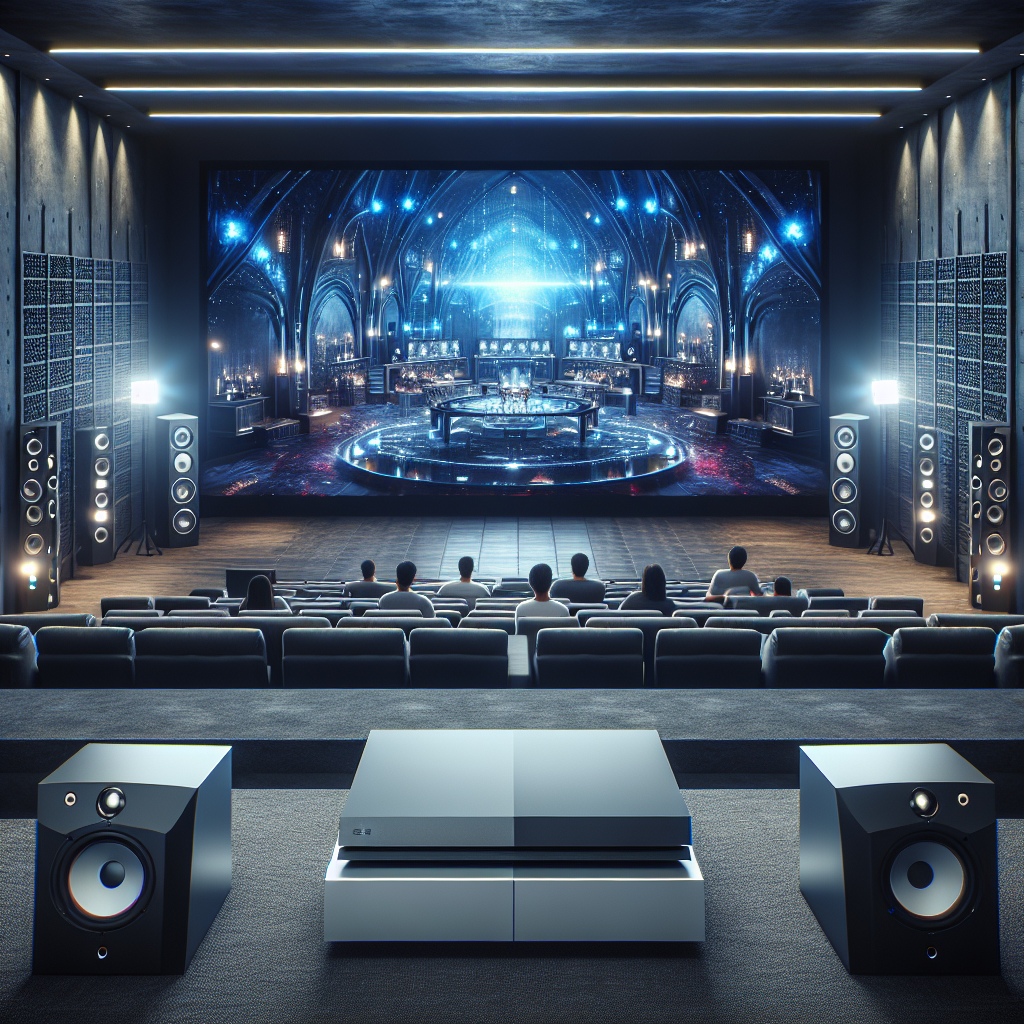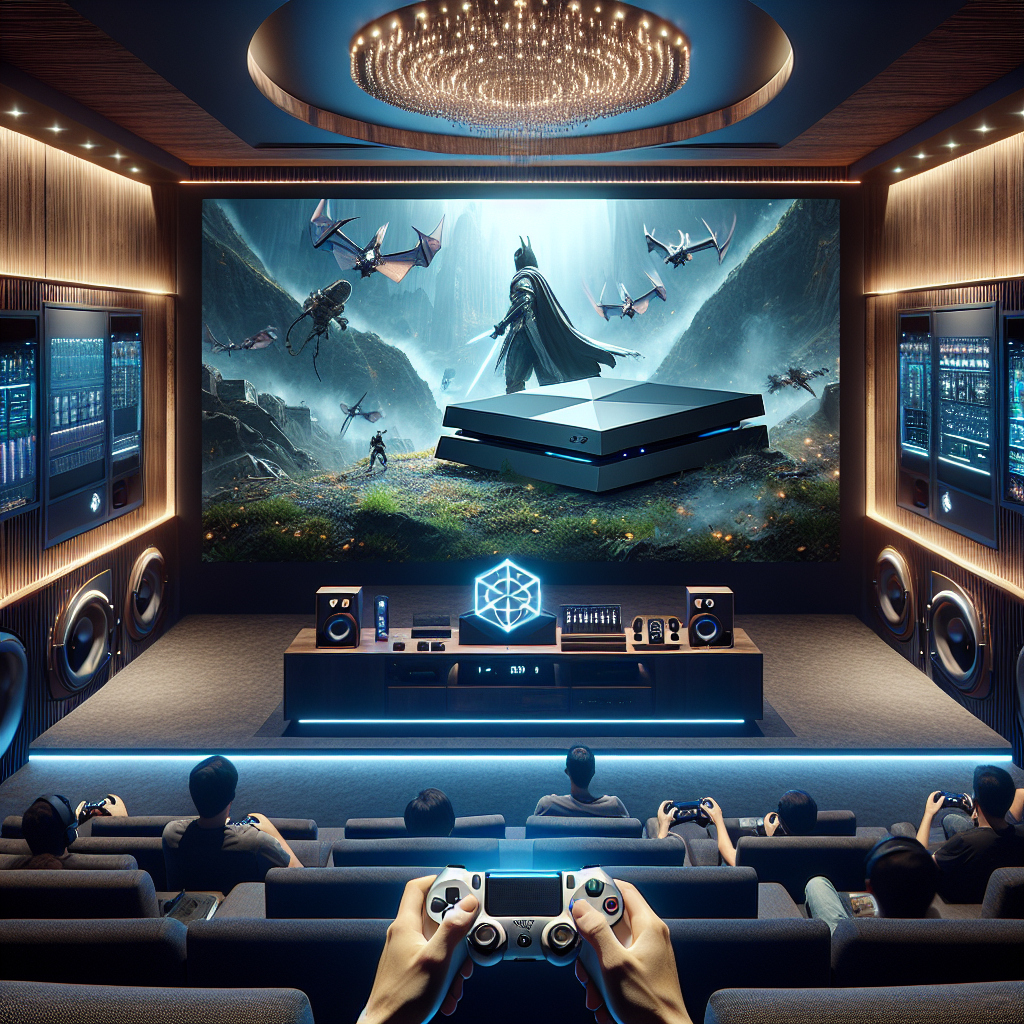
If you’re a gaming enthusiast looking to take your gaming experience to the next level, you may be wondering how to optimize your home theater for gaming on a large screen. With the right tweaks and adjustments, you can transform your living room into a gaming sanctuary that immerses you in captivating visuals, heart-pumping audio, and breathtaking gameplay. In this article, we’ll explore some practical tips and tricks to help you maximize the potential of your home theater system, allowing you to fully indulge in the world of gaming on the biggest screen possible. So, get ready to embark on an exciting journey of enhancing your gaming setup, and prepare to be blown away by the sensational gaming adventures that await you.
Choosing the Right Display
Consider the size of the screen
When it comes to gaming on a large screen, size does matter. You want to make sure you choose a display that is big enough to fully immerse you in the gaming experience. Consider the size of the room and the distance of the seating when selecting the screen size. A screen that is too small may cause you to strain your eyes, while a screen that is too big may result in a loss of detail and immersion.
Choose a display with high resolution
To fully appreciate the stunning graphics of modern games, you need a display with high resolution. The higher the resolution, the clearer and more detailed the images will be. Look for displays with at least 1080p (Full HD) resolution, but if you really want to take your gaming to the next level, consider 4K resolution or even higher.
Look for a display with low input lag
Input lag is the delay between pressing a button on your controller and seeing the action happen on the screen. It can greatly affect your gaming experience, especially in fast-paced games where split-second reactions are crucial. When choosing a display, look for one with low input lag to ensure minimal delay between your actions and the on-screen response. Look for display models that specifically advertise low input lag, as this can vary between different brands and models.
Selecting the Ideal Audio Setup
Invest in a good sound system
While visuals are important, don’t underestimate the power of high-quality audio when it comes to gaming. Investing in a good sound system will enhance your overall gaming experience. Look for a sound system that offers clear, immersive sound to truly transport you into the game world. Consider getting a surround sound system for a more immersive audio experience.
Consider surround sound options
Surround sound can add a whole new dimension to gaming, making you feel like you are right in the middle of the action. Look for audio setups that support surround sound formats such as Dolby Atmos or DTS:X. These formats create a three-dimensional sound stage, with audio coming from all around you. This can greatly enhance your gaming experience, allowing you to hear subtle in-game details and accurately locate enemies or other important sounds.
Choose a setup with low latency
Just as input lag can negatively impact your gaming experience visually, audio latency can also detract from the immersion. Look for audio setups that offer low audio latency to ensure that the sound you hear is in sync with the on-screen action. This is especially important in games where sound cues are crucial, such as first-person shooters or multiplayer games.

Optimizing the Lighting
Dim the lights in the room
Creating the right atmosphere can greatly enhance your gaming experience, and lighting plays a big role in that. Dimming the lights in the room can help to reduce eye strain and create a more focused and immersive environment. Consider using dimmable light fixtures or installing a smart lighting system that allows you to adjust the brightness levels with ease.
Use bias lighting behind the screen
Bias lighting is ambient lighting that is placed behind the display. It can help reduce eye fatigue, improve contrast perception, and minimize the strain caused by bright on-screen content. Set up a bias lighting system by placing LED strips or bias lighting panels behind your screen. This will create a soft glow around the screen, reducing eye strain and improving your overall gaming experience.
Avoid direct light reflections
When setting up your gaming area, make sure to position the display in a way that avoids direct light reflections. Glare and reflections on the screen can be distracting and hinder your ability to see the game clearly. Position the display at an angle where there are no windows or bright light sources directly behind or in front of it. Consider using curtains or blinds to control natural light if necessary.
Positioning the Seating
Find the right distance from the screen
Finding the right seating distance from the screen is crucial for an optimal gaming experience. Sitting too close to a large screen can result in a distorted image and eye strain, while sitting too far away may make it difficult to fully immerse yourself in the game. As a rule of thumb, aim to sit at a distance where the entire screen is visible without having to strain your eyes or move your head too much.
Arrange the seats for optimal viewing angles
In addition to finding the right distance from the screen, it’s also important to consider the viewing angles. Make sure the seats are arranged in a way that allows everyone to have a clear and unobstructed view of the screen. Avoid placing seats at extreme angles, as this can result in distorted images and discomfort during long gaming sessions.
Consider seating options with built-in audio
For the ultimate gaming experience, consider investing in seating options that come with built-in audio. These chairs typically have speakers and vibration feedback embedded, allowing you to feel every explosion and hear every detail right from your seat. This can further enhance the immersion and make you feel like you’re truly part of the game.

Calibrating the Display
Adjust the picture settings
Calibrating the display is essential to ensure you’re getting the best image quality while gaming. Take the time to adjust the picture settings based on your personal preferences and the lighting conditions in the room. Adjust parameters like brightness, contrast, color temperature, and sharpness to achieve the best possible image quality for your gaming sessions.
Perform a color calibration
Color calibration ensures accurate and consistent color reproduction on your display. Use a color calibration tool or consult a professional to calibrate your display’s colors. This will ensure that the colors in your games are displayed as intended by the game developers, providing a more immersive and visually pleasing experience.
Ensure black levels and contrast are optimized
Black levels and contrast are crucial for a visually stunning gaming experience. Adjust the display settings to ensure deep and rich blacks and a balanced contrast ratio. This will result in more detail in dark areas of the game and overall improved image quality.
Managing Audio Settings
Configure audio settings for gaming
Most gaming systems offer audio settings that can be tuned to your preferences. Take the time to explore these settings and customize them to suit your gaming style. Adjust parameters like audio equalization, bass levels, and fine-tune the surround sound settings if applicable.
Ensure virtual surround sound compatibility
Virtual surround sound can simulate a surround sound experience even with just stereo audio output. Check if your gaming system or audio setup supports virtual surround sound and set it up properly. This will enhance your spatial awareness in games and make it easier to pinpoint the direction of in-game sounds.
Set audio presets tailored for gameplay
Many gaming systems offer audio presets specifically designed for different genres of games. These presets can optimize the audio settings to enhance specific aspects of the gameplay experience. Experiment with different presets and find the one that suits your gaming preferences the best.
Reducing Input Lag
Enable gaming mode on the display
Most modern displays offer a gaming mode option that reduces input lag. Enabling gaming mode can significantly reduce the delay between your actions and the on-screen response. This is especially important for fast-paced games where split-second reactions are crucial. Check your display’s settings or consult the user manual to enable gaming mode.
Optimize video settings on the gaming console
In addition to the display’s gaming mode, gaming consoles also offer various video settings that can help reduce input lag. Explore the video settings on your console and look for options like “Game Mode” or “Reduced Latency Mode” to further optimize your gaming experience.
Use a wired connection for the console
Using a wired connection instead of Wi-Fi for your gaming console can help reduce input lag and provide a more stable and consistent connection. Connect your console directly to the router using an Ethernet cable to ensure the best possible gaming experience. This can be especially beneficial for online multiplayer games where a stable and low-latency connection is crucial.
Enhancing Immersion with Gaming Chairs
Choose a gaming chair with built-in speakers
For the ultimate gaming experience, consider investing in a gaming chair with built-in speakers. These chairs often have speakers mounted near the headrest, providing a surround sound-like experience. You’ll be able to feel the deep bass and hear every explosion right from your chair, further immersing yourself in the game.
Consider chairs with vibration feedback
Vibration feedback can add an extra layer of immersion to your gaming experience. Look for gaming chairs that offer vibration feedback in sync with the game’s audio or rumble effects. This can make you feel every impact, explosion, or movement, enhancing the realism and immersion of the game.
Select adjustable chairs for comfort
Long gaming sessions can take a toll on your body, so it’s important to prioritize comfort. Look for gaming chairs that offer adjustable features such as height adjustment, reclining, and armrest adjustments. This way, you can find the most comfortable position for prolonged gaming sessions and avoid discomfort or fatigue.
Eliminating Distractions
Create a dedicated gaming space
Creating a dedicated gaming space can help eliminate distractions and focus your attention on the game. Set up your gaming area in a room or corner of a room that is specifically designated for gaming. This will minimize the chances of interruptions from other activities or household members and create a more immersive gaming environment.
Set up proper cable management
Tangled cables can not only be unsightly but also create distractions and potential hazards. Take the time to set up proper cable management to keep your gaming area organized and free from cable clutter. Use cable management solutions such as cable clips, cable sleeves, or cable raceways to neatly route and secure cables.
Minimize background noise
Background noise can be highly distracting, especially during intense gaming moments. Take steps to minimize background noise in your gaming area. Consider using noise-canceling headphones or soundproofing materials to block out external noise. If possible, choose a room or location in your home that is away from high-traffic areas or noisy appliances.
Choosing the Right Gaming Console
Consider the console’s graphics capabilities
When gaming on a large screen, you want a console that can deliver stunning graphics. Consider the graphics capabilities of various gaming consoles and choose one that suits your needs and budget. Look for consoles that support high-resolution gaming and have the processing power to handle demanding graphics.
Evaluate its support for large displays
Not all gaming consoles are optimized for large displays, so it’s important to consider this factor when making your decision. Look for consoles that offer features specifically designed for big-screen gaming, such as support for high refresh rates, variable refresh rate technology, or compatibility with HDMI 2.1 for higher bandwidth and better video quality.
Look for features specific to gaming on a big screen
Some gaming consoles offer features specifically tailored for gaming on a big screen. Look for features like screen mirroring, multiple display support, or compatibility with gaming projectors. These features can further enhance your gaming experience and allow you to take full advantage of your large screen setup.





